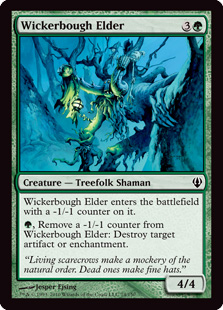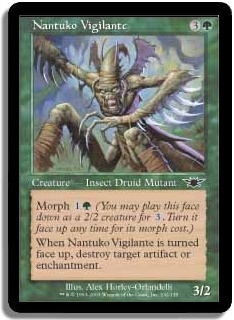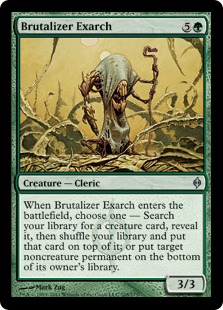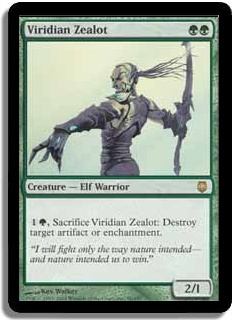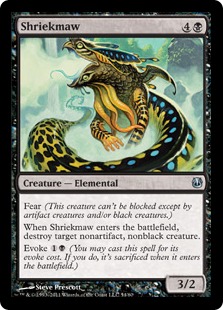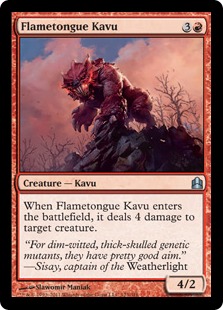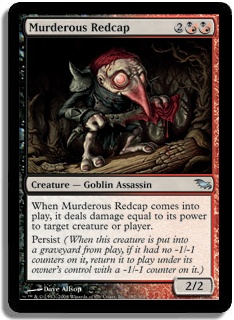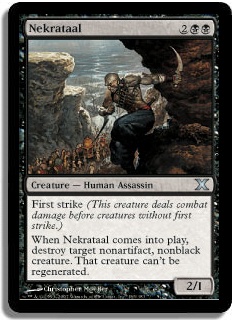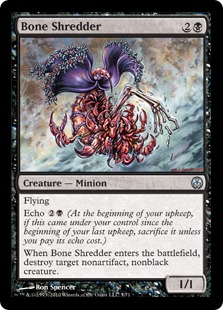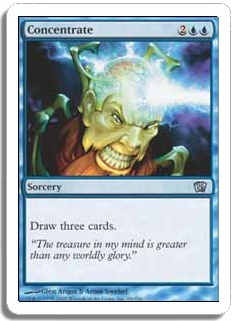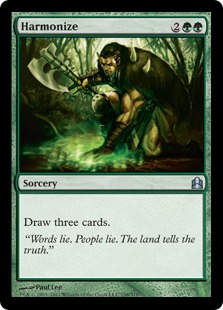In an environment that showcases the most powerful cards in the game, it can be easy to dismiss cards because they don’t look very good when compared
to other cards in a cube. In a previous article, I talked about the concept of
BCSM and WCSM (best-/worst-case scenario mentality
) and how thinking in those exaggerated terms can be detrimental to you as a cube designer and drafter as thinking not in these terms is critical. This
is especially important when evaluating cards that, while not as good as other cube cards, are still very good. In this article, I’ll be discussing how
to evaluate these cards for cube.
I’ve previously said that “not all red direct damage spells are going to be Lightning Bolt, not all two drops are going to be Tarmogoyf and not all
draw spells are going to be Ancestral Recall,” but that’s a pretty obvious statement, isn’t it? Deep Analysis and Fact or Fiction are classic examples
of draw spells that are significantly worse than Ancestral Recall, but is still a very solid card. However, there are many cube cards that “play second
fiddle” to less obvious cube all-stars and are cards that I found get dismissed much earlier than they should.
The idea for this article came about from when I was thinking about some recent experiences when drafting with a friend’s cube that had few answers to
resolved non-creature permanents, which got me to thinking about what “Naturalize/Disenchant on a stick” creatures presently exist for cube designers
to use, so that I could recommend them for use in his cube. He was using Wickerbough Elder and Hearth Kami in his cube but he definitely needed more.
For the sake of argument, let’s say that Wickerbough Elder is the best out of these green creatures. What others should be used in a cube? How do you
figure out what to put in your cube or what to think when you see one of these when drafting? The answer to the latter can be tricky, since it mainly
depends on the needs and archetype of your deck. Taking mana curve of your deck and existing answers to troublesome permanents into account, as in the
deck that I had drafted with few answers to resolved non-creatures, I’d have gladly taken a card like a Nantuko Vigilante, Indrik Stomphowler, or a
Brutalizer Exarch in the draft if I had seen one.
But again, this isn’t earth-shattering: if there’s a weakness in your deck, you should do what you can to fix that weakness when you’re drafting. Isn’t
that what cube decks should be able to do — be able to deal with a myriad of threats from Goblin Guide to Jace, Memory Adept to Sword of Fire and
Ice, because cubes (should) support a variety of decks in the metagame? One of the main reasons that you want to consider the second fiddle cards is
that having those cards in your cube can help to support that variety that cubes should have.
One of the mistakes that I made in the early stages of my cube was that I incorrectly evaluated cards for my cube because I was dismissing cards for my
cube because they looked poor when I compared them to other cards. Making comparisons between cards for cube is generally a good idea, but I found that
by focusing too much on the differences between the cards, it resulted in me thinking disingenuously about cards, dismissing them when I should have
used them on their own merits.
I initially didn’t include Nekrataal or Bone Shredder in my cube because they compared poorly to Shriekmaw, Flametongue Kavu and Murderous Redcap. “I
can’t evoke Nekrataal to kill a creature on the cheap, Nekrataal is smaller and has worse evasion than Shriekmaw and is harder to cast, so I’m not
going to bother with it.” The problem with this mentality is that it completely ignores the fact that even though Nekrataal is worse than Shriekmaw,
Flametongue Kavu, and Murderous Redcap, it’s still an amazing creature that provides card advantage and a ton of value. And even if it does that worse
than Shriekmaw, Flametongue Kavu, and Murderous Redcap, it by no means makes the card bad because those three creatures are amongst the top tier of
cube 187 creatures. Even if Nekrataal arguably isn’t as good as them, it’s still a very good creature!
I then thought that Bone Shredder wasn’t good enough because it also compared poorly to Shriekmaw but again, that method of evaluation was disingenuous
and it didn’t evaluate Nekrataal’s or Bone Shredder’s overall power level correctly. Because of this, my drafters missed out having powerful answers to
opposing threats and their decks were weaker and let’s be honest, if a drafter would have seen a Nekrataal or a Bone Shredder, they wouldn’t have cared
about Shriekmaw being better as either of those cards are powerful in their own right. If I see a Jace Beleren as the best card in a pack and I’m not
cemented into non-blue, I’m not going to complain that it’s not a Mind Sculptor and ship it, I’m going to take the “bad” Jace and be happy about it!
For a lot of these cards that have “inferior” analogues, they’re typically the workhorse types of cards that make cube decks tick — card draw,
non-exciting creatures, removal effects — and having enough of them for all drafters is absolutely key as when I was drafting the cube with few
answers to non-creatures, the decks overall suffered because of the lack of answers.
I find that cubes that inadequately support aggressive strategies do so because they think like I did with Nekrataal and Bone Shredder, especially when
considering one-drops for cube. The argument of “why should I use Jungle Lion or Carnophage for my cube when they’re both worse than Goblin Guide
and Isamaru, Hound of Konda?”, much like the Nekrataal/Bone Shredder argument, also ignores the abstract power level of the one-drops as 2/Xs for one
with a manageable drawback (like being unable to block/taking a damage on upkeep) are powerful creatures in the grand scheme of things, even if
all-stars like Goblin Guide and Isamaru exist. Saying that “Well, cube is all about the all-stars, why should I use the other weak creatures?,” ignores
the fact that those other creatures aren’t weak (at least, they won’t be if they’re given appropriate support, but that’s another article.)
Think back to when Aether Adept was printed. A reprint of Man-o’-War? Great! Many, however, were skeptical of its cubeworthiness because of its 1UU
cost (as opposed to the jellyfish’s 2U,) focusing on the difference in mana cost and increased difficulty of casting, coming to the conclusion that it
wasn’t good enough for their cubes. But was it? The problem with this type of evaluation is that it didn’t focus on what made the original card good,
but it instead focuses on the differences between the two cards — focusing not on Aether Adept providing a 2/2 with an Unsummon for three mana
— but the fact that Aether Adept did it at a harder casting cost, and that is incorrect evaluation because it ignores what should be at the
center of a card’s power level evaluation. For three (1UU or 2U) mana, a 2/2 + Unsummon is a fantastic deal.
When people focus mostly on the negative differences between the two cards, they lose focus on the positive aspects and overall power level of the
card, losing sight of the entire picture. I have also seen this happening when discussing cards like Imperial Seal, with people citing that Imperial
Seal loses a lot of value from it being sorcery speed. But does it? Not really. Eventually, the people in both cases realized that the
differences weren’t anywhere near as bad and realized that the cards were good on the basis of overall power level, which is in the grand scheme of
things, where the heart of cube card evaluation lies.
It’s also important to note that with the comparison of Goblin Guide and Isamaru to Carnophage and Jungle Lion span different colors and it’s important
to not lose focus of that — I didn’t include Kor Sanctifiers in my cube initially as it didn’t look very good compared to Indrik Stomphowler, but
what I should have realized is that Kor Sanctifiers shouldn’t be directly competing with Nantuko Vigilante or Indrik Stomphowler because they’re in
different colors and that for 2WW, Kor Sanctifiers provides a solid disenchant on a creature for the cost, regardless of the existence of Indrik
Stomphowler or Wickerbough Elder. Besides, if a deck like a U/W deck has the appropriate mana fixing to splash for a Nantuko Vigilante or Indrik
Stomphowler, it won’t be able to utilize those green cards anyway, so why is it even considering green options?
Similarly, almost no cubes use Concentrate but many more cubes use Harmonize since although green gets access to card advantage tools through cards
like Viridian Shaman, Cultivate, and Life from the Loam, green doesn’t get much access to direct card draw effects outside of cantrip-style ones like
Krosan Tusker and Yavimaya Elder, while blue has the luxury of better card draw effects like Deep Analysis, Fact or Fiction and Jace Beleren. Granted,
a lot of cubes have started to cut Harmonize as competition has been very tight for non-creature spells in green from cards like the new Garruks, but
due to the lack of card draw options in green, Harmonize has remained in cubes much longer than Concentrate.
I’m by no means advocating using bad cards that provide “weaker but similar” effects to others in a cube because they still serve a useful
function like using a card like Oxidize, since that’d be losing focus of the card’s power level and going too far in the opposite direction —
using suboptimal cards because they do something similar to other cards in a cube — and an important thing to realize when acting as a cube
designer and player is to realize when a card was useful to you, if it is truly good enough for your cube, or if you’re just being results oriented and
focusing on a card helping in a certain situation.
I’m by no means advocating using bad cards that provide “weaker but similar” effects, like using Oxidize along with better versions of it. An important thing to realize when acting as a cube designer and as a player is to realize
when a card was useful to you, if it’s really good enough for the cube,
or if you’re just focusing too much on results and when the card has been useful in rare situations.
For example, if I’m in a draft and I need an artifact removal or a creature removal effect and haven’t been able to draft any (either due to a
cube not having many in the pool or me just not seeing them,) I’ll use a loose card like Oxidize or Eyeblight’s Ending as it addresses a weakness of my
deck, but I’d still be aware that both cards aren’t very good in cube when it comes down to objectively evaluating the card’s power level.
It can be difficult to see where the threshold lies when determining whether a card just looks bad compared to a very powerful cube card or whether the
card’s just not cubeworthy. Sometimes it depends on the needs of a cube — if certain types of cards are taking over a cube, using cards “lower
down the ladder” (like Mold Shambler or Viridian Zealot compared to Wickerbough Elder) can help to mitigate those types of cards, but it’s all just
about objectively looking at power level. Even Mold Shambler and Viridian Zealot need to be competitive at six and two mana respectively to be
considered for a cube. A year ago, I’d have never thought that I would be cutting Volcanic Hammer and Fire Ambush from my cube as those were cards that
got the job of dealing damage done. Those cuts weren’t just made because burn got better and the cards got upgraded — it’s that the power level
of red overall just got that much better and Volcanic Hammer and Fire Ambush just couldn’t compete in my cube anymore due to their power level.
I hope that this article has given you some insight into looking at cards in a realistic manner and to not get hung up on dismissing cards as bad for
your cube or cube deck because they compare poorly to some cube cards, looking at cards in a holistic manner.
May all of your opening packs contain Sol Rings!
@UsmanTheRad
on Twitter
My blog featuring my powered & pauper cube lists: http://idratherbecubing.wordpress.com
Cube podcast that Anthony Avitollo and I
co-host: The Third Power

